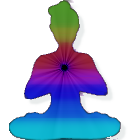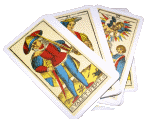
Haindl Tarot
MOTHER OF WANDS - KALI
Kali Ma. The Black Mother, Mother Night. Kali Mahadeva. The Great Mother Goddess. The modern sage Sri Ramakrishna prayed for a vision before her statue. The temple, the floor, the walls, all disappeared. He knew nothing but the Mother. Later, he wrote, "Maha-Kali, the Great Power, was one with Maha-Kala, the Absolute." European commentators and some Indians describe her as a minor deity or even a demon. For the people, however, Kali has always been important, even popular, despite her fearsomeness. She is Mother Kali.
For followers of Tantra, Kali is supreme. She is Creator, Preserver, Destroyer. Most people know these titles for the three primary Gods, Brahma, Vishnu, Shiva. But the Tantric texts insist that even Trimurti (as the three are called) were born out of Kali's infinite being. In Tantra, one of the keys to life - to accepting and rejoicing in the world - is the knowledge that the Goddess who creates the universe and the Goddess who destroys it are one and the same. ( In this way, she recalls the Fool, number 0 in the Major Arcana.) Kali's main color is black, for nonbeing, the Nothing beyond creation. But she also appears in red, for the Mother who gives birth, and even in white, for the pure Virgin. Thus we find in her the Triple Goddess of Maiden, Mother, and Crone. We see her here as the Black Mother of Wands. She wears a Moon crown, like the High Priestess, the traditional Tarot's version of the Absolute as female.
Kali epitomizes what Erich Neumann has termed "The Terrible Mother." We call her "Kali the Merciless," drinker of blood. Joseph Campbell tells us that until 1835 (when the British put an end to human sacrifice in India), priests beheaded a male child in front of Kali's statue in the city of Tanjore, at the temple of Shiva. The texts tell us that blood appeases her anger, and without it she will become uncontrollable, and destroy the universe. For Kali is Fire, and Fire destroys as well as creates. (However, my friend Anne Ogborn, knowledgeable about contemporary Indian religious practice, tells me that human sacrifice is anathema to Hindu tradition, and such stories as Campbell describes were British propaganda.)
For all the terror of her countenance, Kali is not shunned by Hindus. Homes sometimes display shrines to her, for she protects her people against disasters. In one story, Kali first appeared (took shape out of her limitless being) when a great demon threatened the Gods. Even Shiva found himself powerless against the monster, and so Parvati (another aspect of Shiva's female side) knitted her brows and Kali sprang from her forehead. She killed the demon and then she went wild, dancing her ecstasy. Now, ecstasy is dangerous, the more powerful the more dangerous, for ecstasy breaks down the neat, orderly universe. With Kali threatening existence itself, Shiva went to plead with her. In her wildness she cast him down, and would have trampled him if some remnant of awareness hadn't broken through her dance, so that at the last moment Kali saw Shiva lying beneath her and forced herself to stop. But even though she ended her dance, she did not vanish back into Parvati. Once we experience that wild ecstasy, we can no longer pretend it does not exist. From this we see that we make a mistake to believe that Kali primarily represents violence. Ecstasy, not brutality, destroys the outer world of appearances.
The story of Kali dancing resembles very much a number of stories about Shiva, including a similar one where Brahma and the other Gods plead for his help in destroying a triple city of the demons. There, too, Shiva goes wild with excitement and begins a dance that will dissolve the universe. Shiva, too, stops at the last moment, with the promise that one day he will dance again and the universe will truly end.
We find roughly the same story about both Kali and Shiva because they are the same. They are two aspects of the divine energy that create the magnificent illusion of the universe - with all its billions of stars, its unimaginable distances, its smaller and smaller molecules, particles, quarks, infinitesimal strings - and will one day return it to Nothing. Shiva and Kali are the same, for like the Fool, they both come out of emptiness, and how can nothing be one thing or another? And yet - the great paradox - Kali is older than all, for she is Mother Night, and without her gifts, life cannot exist.
Kali is the dark mirror of Shakti. We saw in the Empress how Shiva lies unmoving, like stone (a stone lingam) without the female energy to empower him. But if the Goddess can give the energy, she can draw it back, too. We see in the picture Kali copulating with a dead Shiva. Hermann Haindl has said that she has not killed Shiva, but that Shiva returns to her, gives himself to her. We see him upside down, like the Hanged Man. A snake winds around him, again in reversed form, for the tail begins over the crown, and the body coils past Shiva's third eye to wind around his chest, the seat of the heart.
We see Kali as black, with stars behind her and the Moon above her own third eye. When she takes the universe inside her, nothing will exist but the Great Night, the Deep. She wears a red cloak, for Fire, and her red tongue hangs out, a symbol of life and strength. Three lines appear in places along Kali's body. They signify the Triple Goddess. Notice that they form the I Ching trigram "Creative." And notice, too, that when the figure becomes doubled on her chest, it changes to the opposite trigram, "Receptive." The Great Mother contains all things.
Kali has six limbs, and six is the number of the Lovers. As we learned in the Major Arcana, spiritual ecstasy and sexual ecstasy arise from the same energy. Here we see the danger of that energy, even the reason why people suppress it, for it can overwhelm consciousness. Kali's four limbs hold objects of her power. Since Haindl painted this card directly from traditional pictures, he himself has not identified the red mound before her belly. The other hands hold a three-pronged trident (also the weapon of Shiva) and a sickle. Though Shiva lies on a mat, Kali squats with her feet touching the Earth. She looms up huge against the sky; behind her we can see the curve of the planet.
DIVINATORY MEANINGS
In readings, the Mother of Wands signifies a person - not necessarily a woman - with a wild female kind of energy. She can be vindictive, even cruel. However, she can also be a loving mother. She exults in her own power. She does not recognize boundaries, especially those of conventional morality. She has a dark power and a wild sexual energy. As a lover she awakes and gives passion. Her partner, however, may feel overwhelmed at times, even frightened.
Hermann Haindl describes Kali as the strongest, the most magical of all the Mothers. He sees her as basically positive, for she represents a person who can deal with the dark energy of her own desires.
REVERSED
Reversed, the Mother of Wands shows these things contained. A person has Kali-like potential but stifles it, probably for the sake of being nice or proper. The person might not even know she has this energy. Kali does not exist in the world until the Gods need her destructive power. And she springs full-grown from the forehead (like warrior Athena springing from the head of Zeus). This indicates that even though the power is sexual, it lies in the mind. With reversed Kali, the mind contains the energy, even hides it from conscious awareness. But if something triggers its release (the reading may concern that something) then it can overwhelm the person as well as those around her.
Another aspect of the reversed card would seem the opposite. It can indicate the destructive side of Kali taking over, outweighing the joy and love. The two aspects are related, for the powerful personality can become distorted when Kali tries to act in a conventional way.










